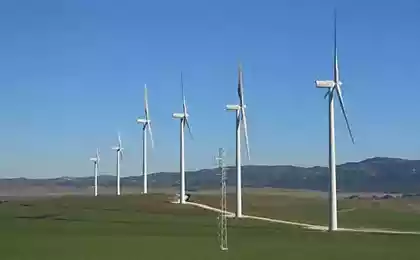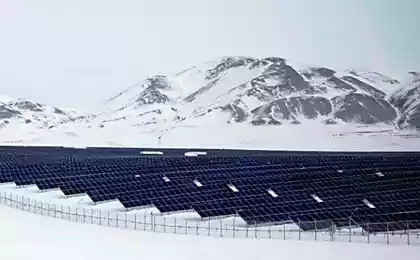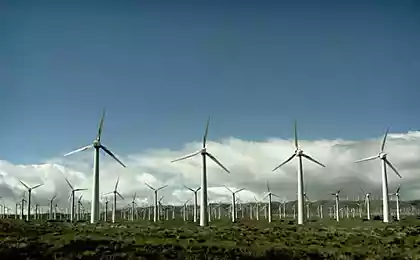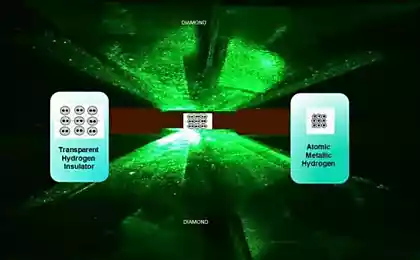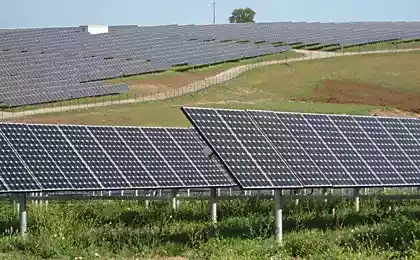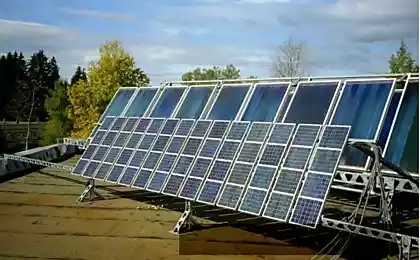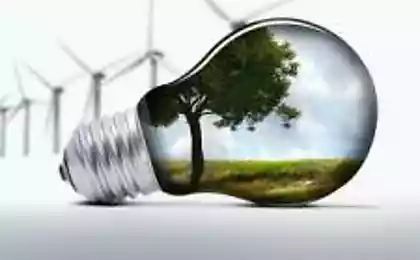539
The accumulation of energy in the air HES
The HES, as with other RES (renewable energy sources: sun, wind and others), the climate and need of energy storage, except when HES is used only to receive water. While renewable energy sources, including the HES is connected to the electric grid and take a minor share in the generation of EE, the problem of accumulation should not be too acute, as the traditional sources will be able to cover the unevenness of the production of renewable energy.
However, these arguments are unacceptable when using the HES as Autonomous energy source, for example, for the purposes of the army, Navy, or MES.
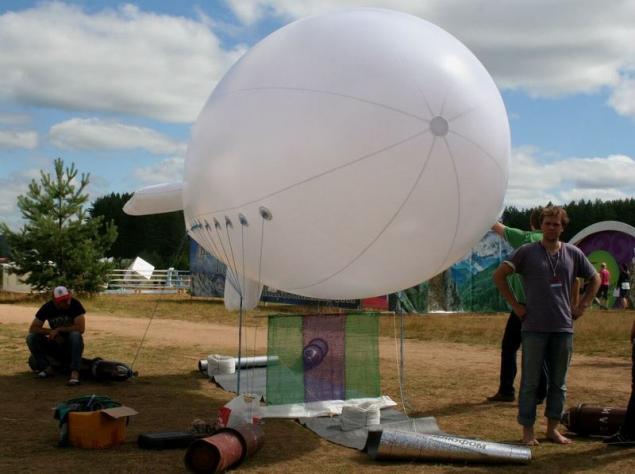
On average, according to NASA cloud cover 67% of the Earth's surface, and in terms of natural factors, the HES is of uniform generation looks even better than the other RES, with a typical capacity factor of ~ 20-40%. Nevertheless, we can distinguish the following three levels of irregularity that you need to consider:
Local unevenness — gaps in the flow of the clouds. Meteo irregularity — change like weather (for example, "overcast" to "clear"). Seasonal fluctuations — change of seasons (e.g., winter). It is obvious that for each type of unevenness, you can use different approaches. In General, we can suggest the following possible measures:
1. Traditional chemical batteries. In many works on renewable energy shows that of all available methods of energy storage of conventional lead-acid batteries remain the cheapest method of storage (~$150/kWh of capital investment, with the limit of 500 full discharge cycles or in terms of costs over the lifetime of the battery ~$0.30/kWh in the characteristics of ~0.013m3/kWh, ~25kg/kWh, an efficiency of ~80%).
2. Local pump storage. This is one of the benefits of HES over other renewable energy sources. The air HES can hold a certain amount of water upstream, which will require additional costs for aerostatic hold. It is easy to calculate that at the height of 2 km for every kg of water stores 1kg*10m/S2*2000m = 0.02 MJ = 0.0056 kWh for the retention of which requires approximately 1 m3 or 0.1 kg of hydrogen with a minimum current value of ~$0.2-0.3, which is equivalent to ~$35-53/kWh, which is at least three times cheaper than chemical batteries. Really benefit, even more so as the HES do not buy the hydrogen, but produces it itself, i.e. does not generate any external costs. There are no limits on cycles hidroakumuliacines and usually higher efficiency. In addition, the control of water upstream gives you additional convenient control mechanism lifting height of the HES is to optimize the collection of water.
However, even without this extra supply of water, the HES may use or the supply of water, which is still in the hose and the grids. For example, for a basic technical prototype of the feasibility study water supply hose for average performance evaluation is 3572 kg. Given that the average pressure of this water is only half of the original, i.e. 1 km, the received energy is ~10 kWh, which corresponds to several minutes, during which the HES will continue to work, gradually reducing power of the nominal power of 185 kW (for example, in the case of a break in the flow of the clouds).
3. Cascade pump storage. This is another key advantage of the HES is fixed. As you know, one of the best solutions to the problem of non-uniformity for any renewable energy is now using PSP. For this purpose, using a suitable elevation, building reversible hydropower, which operates in a pump in generator mode. While the efficiency of reversible hydraulic units typically significantly worse than conventional turbines.
The HES is of the cascade type elegantly solves this problem, at the same time solving the problem of its meteozavisimosti. If you have a suitable hill, but it is not no river flows, the HES can easily organize this "river" and an intermediate upstream, draining your water in the natural (climate) mode-up to downstream, and before that the intermediate upper tail such a cascade HPP.
Then this lower hydro and will play the role of accumulator, with a normal hydraulic turbines, and coordinated work of the HES is and this cascading conventional hydropower will completely eliminate the weather dependent. Pump mode it is possible to eliminate the pump will work itself out the sun, raising water to the clouds.
4. Induced or surface condensation. Another possibility is the variability associated with the physical principles of operation of the air HES. In normal grid mode, the HES is designed to capture the droplets of clouds, ie use the moisture from the effect of volumetric condensation. However, it is assumed that in the absence of clouds in the grids of the air HES should occur surface condensation (like the fall of dew), because of technology, they obviously raised above the dew point. According to preliminary estimates, this effect is, of course, will provide much less water than sifting clouds, but nevertheless this effect should exist and can be verified experimentally.
5. The accumulation of hydrogen. Here HES also has a considerable advantage over other renewable energy sources. Transformation, accumulation and use of energy in the form of hydrogen is one of the main ideas of alternative energy to replace hydrocarbon fuels. With relatively small modifications, hydrogen can be used in virtually all energy and transportation installations that currently use hydrocarbons, which creates the possibility of a gradual transition to a new green energy with minimal cost and without major destruction of the old energy infrastructure.
The main problem for all other forms of renewable energy in the production of hydrogen from excess energy — a lack in the location of solar panels or wind turbines sources of fresh water high quality cleaning for work cells. In contrast, the HES has excess energy, and a perfect fresh water (almost distilled). Moreover, HES is technologically and structurally may in a natural way to store hydrogen in their balloons, or even to transport the accumulated hydrogen in such balloons (in the form of an airship) to the consumer. It is easy to calculate that in this way it is possible to modify the HES to increase its storage capacity of approximately 600 times! Except for enough conduit to pull down and Vodorezova and use ballantye balloons, which not only will ensure the maintenance of elements of the HES, but also to keep stock of hydrogen as energy-accumulating agent.
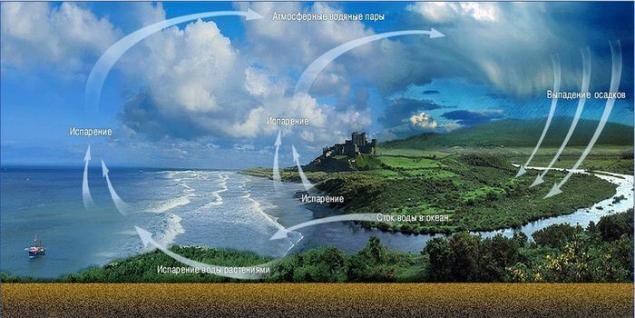
It is easy to show that 1 kg (10 m3) of hydrogen (specific heat of combustion of 120.9 MJ/kg) holds upstream approximately 10 kg of water with a supply of hydro power is only 0.2 MJ. Thus, the HES is in the period of overproduction of energy can be achieved by injection of hydrogen (obtained by electrolysis at the bottom) and balanced water drain to provide the necessary amount of water upstream (to maintain structure in the equilibrium condition and minimize tension restraint cables) and increased by 600 times the amount of energy that energy can always be as well balanced get back in fuel cells (hydrogen) and the turbine (from the water).
So we see that of the five possible ways of dealing with weather dependent, four are either the exclusive or a significant advantage of the HES is to other renewable energy sources.
Consider the approximate impact on the feasibility consideration of energy storage to the minimum (1.85 kW) and basic (185 kW) technical prototype.
Local unevenness — gaps in the flow of the cloudssince the value of the integral performance of the air HES in the feasibility study based on integrated data-gathering mist, and the appropriate water flow, it allows for the source irregularity in obtaining this data which is rather difficult to assess.
In the case of the HES is, we propose to use the low clouds (layered rain, stratocumulus, stratus) and clouds with vertical development (Cumulus, cumulonimbus). Most of these clouds have a duty cycle close to 1, i.e., are almost continuous layer. Suppose for our imputation, the HES should consistently work even when the duty ratio of 2 despite the fact that such a regime can be up to 10% of the time. For typical sizes of the clouds ~ 1 km and the typical wind speed at a height of 2 km ~ 10 m/s this means that the HES should provide the rated production at a gap of clouds ~ 1 km, i.e. within ~ 100 seconds, which corresponds to a one-time necessary for the accumulation of 185 kJ (~0.05 kWh) and 18500 kJ (~5кВтч), respectively, and in storage for ~ 1 year, i.e. for energy about half of the output within 10% of the calculated life time of installation in 10 years.
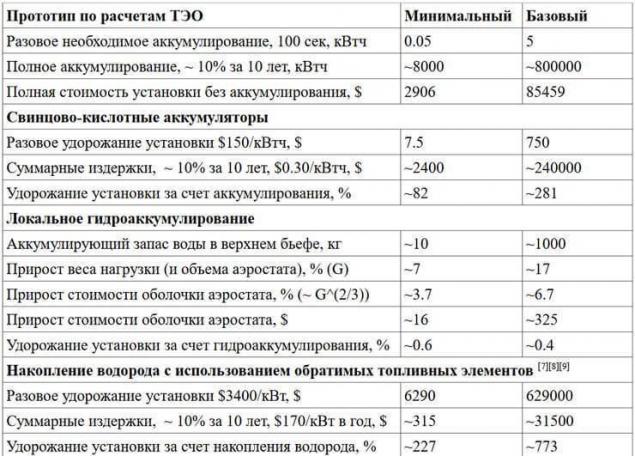
Thus, the local unevenness of the HES is easy to handle due to local hidroakumuliacines, which already gives her a global advantage over solar and wind energy, where for the solution of such problems it is necessary to use lead-acid batteries with a reusable more expensive renewable energy.
Meteo irregularity — change type of weather, Meteo-uniformity for a particular location can be estimated from meteorological archives, or data of meteorological satellites of NASA. For example, for SPb analysis of cloudiness in the warm season shows that the change of type of weather from "cloudy" to "clear" may be in duration up to about one week with a periodicity of about one month, i.e. the total number of cycles of charge-discharge (120) will not exceed the limit cycles of the battery (500), and maintenance costs can be neglected. It is obvious that the local power plant of any type of renewable energy can not cope with the accumulation of a week's production (unless it is a stationary unit that can implement a cascading scheme of the HES). However, we will have the corresponding calculations.

Thus, as expected, no choice is acceptable. Meanwhile, according to Wikipedia, you can expect lower cost reversible fuel cell to the level of $254/kWh (General Electric, 2006), then this option would be acceptable. In addition, this type of fuel cell can use not only hydrogen but ordinary propane, allowing it to be used instead of backup diesel generator (DG).

However, to date, still have to use DG as a backup source of supply.
Seasonal fluctuations — the change of seasonsAs has been said, the air HES can work year-round only in the southern countries. In Russia there are droplet cloud in the lower troposphere is only about six months, i.e., the HES have for the warm period of the year or accumulate a sufficient amount of water to cascade hydropower or accumulate a sufficient amount of hydrogen to use his remaining six months in fuel cells or in lieu of natural gas in the existing power system, or just be replaced at this time traditional energy sources. For the case of offline application at present for any renewable energy as a backup source of energy using DG. Compare the technical and economic characteristics at the Autonomous year-round use of only DG or DG+HES in the conditions of Central Russia. We assume that, given the winter and the weather changes, the HES will be able to actively work only a third of the time of year. Market analysis of diesel and petrol generators will take the average valuation of ~$150/kW and costs ~$0.15/kWh.
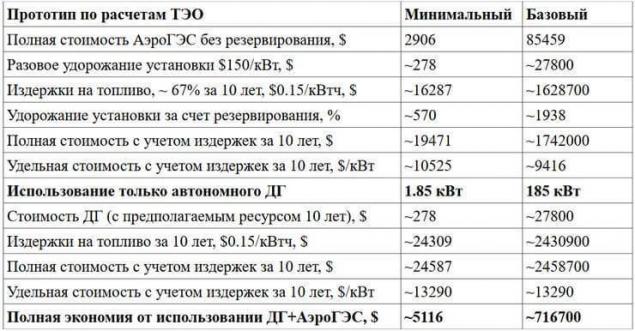
Also consider using fuel cells instead of DG, suggesting that we have to use in the summer for three modules of the HES instead of one to 2/3 energy reserve for the winter in the form of hydrogen.

Thus, even the option of using the old reversible fuel cell to supply the hydrogen required for extended six-month reserve, along with triple the air HES (with the results of the same capacity) is advantageous compared to the DG.
A comparison of the cost of wateras the HES produces not only energy but also fresh (almost perfect distilled) water, it is possible to estimate the cost of such water compared to alternative technologies, for example, for the needs of the Navy or of the Ministry.

From the calculations of the feasibility study suggests that even if the HES will be used only for the production of water, the cost of such water will be extremely small. For example, even minimal technical prototype will be made on the day ~10 ton or m3 of water, which when converted to a life of 10 years gives 36500 tons or ~9.64 million gallons, ie the cost of water will be ~ $0.08/m3 or ~ $0.3 per 1000 gallons, which is several times cheaper than other technologies listed in the table. Basic technical prototype will give water even cheaper: ~ $0.02/m3 or ~ $0.09 per 1,000 gallons. Despite the fact that the production of such water will not consume and produce energy... posted
Source: altenergiya.ru/gidro/akkumulirovanie-energii-v-aeroges.html
However, these arguments are unacceptable when using the HES as Autonomous energy source, for example, for the purposes of the army, Navy, or MES.

On average, according to NASA cloud cover 67% of the Earth's surface, and in terms of natural factors, the HES is of uniform generation looks even better than the other RES, with a typical capacity factor of ~ 20-40%. Nevertheless, we can distinguish the following three levels of irregularity that you need to consider:
Local unevenness — gaps in the flow of the clouds. Meteo irregularity — change like weather (for example, "overcast" to "clear"). Seasonal fluctuations — change of seasons (e.g., winter). It is obvious that for each type of unevenness, you can use different approaches. In General, we can suggest the following possible measures:
1. Traditional chemical batteries. In many works on renewable energy shows that of all available methods of energy storage of conventional lead-acid batteries remain the cheapest method of storage (~$150/kWh of capital investment, with the limit of 500 full discharge cycles or in terms of costs over the lifetime of the battery ~$0.30/kWh in the characteristics of ~0.013m3/kWh, ~25kg/kWh, an efficiency of ~80%).
2. Local pump storage. This is one of the benefits of HES over other renewable energy sources. The air HES can hold a certain amount of water upstream, which will require additional costs for aerostatic hold. It is easy to calculate that at the height of 2 km for every kg of water stores 1kg*10m/S2*2000m = 0.02 MJ = 0.0056 kWh for the retention of which requires approximately 1 m3 or 0.1 kg of hydrogen with a minimum current value of ~$0.2-0.3, which is equivalent to ~$35-53/kWh, which is at least three times cheaper than chemical batteries. Really benefit, even more so as the HES do not buy the hydrogen, but produces it itself, i.e. does not generate any external costs. There are no limits on cycles hidroakumuliacines and usually higher efficiency. In addition, the control of water upstream gives you additional convenient control mechanism lifting height of the HES is to optimize the collection of water.
However, even without this extra supply of water, the HES may use or the supply of water, which is still in the hose and the grids. For example, for a basic technical prototype of the feasibility study water supply hose for average performance evaluation is 3572 kg. Given that the average pressure of this water is only half of the original, i.e. 1 km, the received energy is ~10 kWh, which corresponds to several minutes, during which the HES will continue to work, gradually reducing power of the nominal power of 185 kW (for example, in the case of a break in the flow of the clouds).
3. Cascade pump storage. This is another key advantage of the HES is fixed. As you know, one of the best solutions to the problem of non-uniformity for any renewable energy is now using PSP. For this purpose, using a suitable elevation, building reversible hydropower, which operates in a pump in generator mode. While the efficiency of reversible hydraulic units typically significantly worse than conventional turbines.
The HES is of the cascade type elegantly solves this problem, at the same time solving the problem of its meteozavisimosti. If you have a suitable hill, but it is not no river flows, the HES can easily organize this "river" and an intermediate upstream, draining your water in the natural (climate) mode-up to downstream, and before that the intermediate upper tail such a cascade HPP.
Then this lower hydro and will play the role of accumulator, with a normal hydraulic turbines, and coordinated work of the HES is and this cascading conventional hydropower will completely eliminate the weather dependent. Pump mode it is possible to eliminate the pump will work itself out the sun, raising water to the clouds.
4. Induced or surface condensation. Another possibility is the variability associated with the physical principles of operation of the air HES. In normal grid mode, the HES is designed to capture the droplets of clouds, ie use the moisture from the effect of volumetric condensation. However, it is assumed that in the absence of clouds in the grids of the air HES should occur surface condensation (like the fall of dew), because of technology, they obviously raised above the dew point. According to preliminary estimates, this effect is, of course, will provide much less water than sifting clouds, but nevertheless this effect should exist and can be verified experimentally.
5. The accumulation of hydrogen. Here HES also has a considerable advantage over other renewable energy sources. Transformation, accumulation and use of energy in the form of hydrogen is one of the main ideas of alternative energy to replace hydrocarbon fuels. With relatively small modifications, hydrogen can be used in virtually all energy and transportation installations that currently use hydrocarbons, which creates the possibility of a gradual transition to a new green energy with minimal cost and without major destruction of the old energy infrastructure.
The main problem for all other forms of renewable energy in the production of hydrogen from excess energy — a lack in the location of solar panels or wind turbines sources of fresh water high quality cleaning for work cells. In contrast, the HES has excess energy, and a perfect fresh water (almost distilled). Moreover, HES is technologically and structurally may in a natural way to store hydrogen in their balloons, or even to transport the accumulated hydrogen in such balloons (in the form of an airship) to the consumer. It is easy to calculate that in this way it is possible to modify the HES to increase its storage capacity of approximately 600 times! Except for enough conduit to pull down and Vodorezova and use ballantye balloons, which not only will ensure the maintenance of elements of the HES, but also to keep stock of hydrogen as energy-accumulating agent.

It is easy to show that 1 kg (10 m3) of hydrogen (specific heat of combustion of 120.9 MJ/kg) holds upstream approximately 10 kg of water with a supply of hydro power is only 0.2 MJ. Thus, the HES is in the period of overproduction of energy can be achieved by injection of hydrogen (obtained by electrolysis at the bottom) and balanced water drain to provide the necessary amount of water upstream (to maintain structure in the equilibrium condition and minimize tension restraint cables) and increased by 600 times the amount of energy that energy can always be as well balanced get back in fuel cells (hydrogen) and the turbine (from the water).
So we see that of the five possible ways of dealing with weather dependent, four are either the exclusive or a significant advantage of the HES is to other renewable energy sources.
Consider the approximate impact on the feasibility consideration of energy storage to the minimum (1.85 kW) and basic (185 kW) technical prototype.
Local unevenness — gaps in the flow of the cloudssince the value of the integral performance of the air HES in the feasibility study based on integrated data-gathering mist, and the appropriate water flow, it allows for the source irregularity in obtaining this data which is rather difficult to assess.
In the case of the HES is, we propose to use the low clouds (layered rain, stratocumulus, stratus) and clouds with vertical development (Cumulus, cumulonimbus). Most of these clouds have a duty cycle close to 1, i.e., are almost continuous layer. Suppose for our imputation, the HES should consistently work even when the duty ratio of 2 despite the fact that such a regime can be up to 10% of the time. For typical sizes of the clouds ~ 1 km and the typical wind speed at a height of 2 km ~ 10 m/s this means that the HES should provide the rated production at a gap of clouds ~ 1 km, i.e. within ~ 100 seconds, which corresponds to a one-time necessary for the accumulation of 185 kJ (~0.05 kWh) and 18500 kJ (~5кВтч), respectively, and in storage for ~ 1 year, i.e. for energy about half of the output within 10% of the calculated life time of installation in 10 years.

Thus, the local unevenness of the HES is easy to handle due to local hidroakumuliacines, which already gives her a global advantage over solar and wind energy, where for the solution of such problems it is necessary to use lead-acid batteries with a reusable more expensive renewable energy.
Meteo irregularity — change type of weather, Meteo-uniformity for a particular location can be estimated from meteorological archives, or data of meteorological satellites of NASA. For example, for SPb analysis of cloudiness in the warm season shows that the change of type of weather from "cloudy" to "clear" may be in duration up to about one week with a periodicity of about one month, i.e. the total number of cycles of charge-discharge (120) will not exceed the limit cycles of the battery (500), and maintenance costs can be neglected. It is obvious that the local power plant of any type of renewable energy can not cope with the accumulation of a week's production (unless it is a stationary unit that can implement a cascading scheme of the HES). However, we will have the corresponding calculations.

Thus, as expected, no choice is acceptable. Meanwhile, according to Wikipedia, you can expect lower cost reversible fuel cell to the level of $254/kWh (General Electric, 2006), then this option would be acceptable. In addition, this type of fuel cell can use not only hydrogen but ordinary propane, allowing it to be used instead of backup diesel generator (DG).

However, to date, still have to use DG as a backup source of supply.
Seasonal fluctuations — the change of seasonsAs has been said, the air HES can work year-round only in the southern countries. In Russia there are droplet cloud in the lower troposphere is only about six months, i.e., the HES have for the warm period of the year or accumulate a sufficient amount of water to cascade hydropower or accumulate a sufficient amount of hydrogen to use his remaining six months in fuel cells or in lieu of natural gas in the existing power system, or just be replaced at this time traditional energy sources. For the case of offline application at present for any renewable energy as a backup source of energy using DG. Compare the technical and economic characteristics at the Autonomous year-round use of only DG or DG+HES in the conditions of Central Russia. We assume that, given the winter and the weather changes, the HES will be able to actively work only a third of the time of year. Market analysis of diesel and petrol generators will take the average valuation of ~$150/kW and costs ~$0.15/kWh.

Also consider using fuel cells instead of DG, suggesting that we have to use in the summer for three modules of the HES instead of one to 2/3 energy reserve for the winter in the form of hydrogen.

Thus, even the option of using the old reversible fuel cell to supply the hydrogen required for extended six-month reserve, along with triple the air HES (with the results of the same capacity) is advantageous compared to the DG.
A comparison of the cost of wateras the HES produces not only energy but also fresh (almost perfect distilled) water, it is possible to estimate the cost of such water compared to alternative technologies, for example, for the needs of the Navy or of the Ministry.

From the calculations of the feasibility study suggests that even if the HES will be used only for the production of water, the cost of such water will be extremely small. For example, even minimal technical prototype will be made on the day ~10 ton or m3 of water, which when converted to a life of 10 years gives 36500 tons or ~9.64 million gallons, ie the cost of water will be ~ $0.08/m3 or ~ $0.3 per 1000 gallons, which is several times cheaper than other technologies listed in the table. Basic technical prototype will give water even cheaper: ~ $0.02/m3 or ~ $0.09 per 1,000 gallons. Despite the fact that the production of such water will not consume and produce energy... posted
Source: altenergiya.ru/gidro/akkumulirovanie-energii-v-aeroges.html
Reveals the connection between vitamin D deficiency and autism
BikeBoards turns the bike in winter transport


